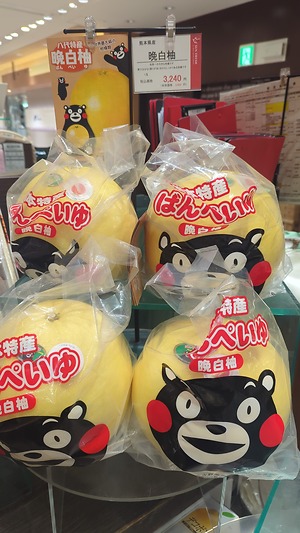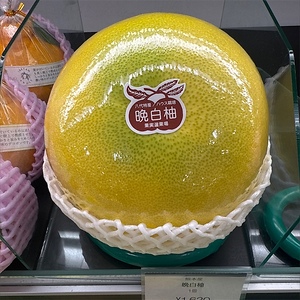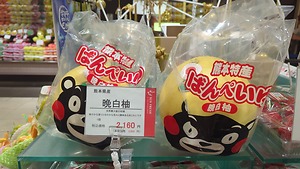


Banpeiyu Pomelos
Estimated Inventory, lb : 0
Description/Taste
Banpeiyu is a large pomelo varietal that can reach 20 to 25 centimeters in diameter and 1.5 to 3 kilograms in weight. The fruits are round to oblate with a curved, uniform nature, and the skin is thick, smooth, glossy, and taught. The surface also features prominent, pitted oil glands that release fragrant essential oils when scratched or rubbed. These glands create a lightly pebbled feel across the fruit’s surface. The skin is tightly adhered to a thick layer of white pith, also known as the albedo. This pith is spongy, dry, fragrant, and edible. It is said the more pith a Banpeiyu contains, the sweeter the flesh will be. The pale-yellow flesh is divided into 15 to 18 segments by thin but tough membranes, and the flesh is comprised of large vesicles that contain little to no juice. The flesh is also firm with a crisp, chewy, and succulent consistency and contains many ivory seeds that should be discarded during consumption. When sliced or torn, Banpeiyu releases a mild, refreshing, sweet, and sour aroma. The fruits should feel heavy for their size and are ready to be eaten when the skin is soft and a finger mark is left when pressed into the fruit’s surface. Banpeiyu pith and flesh are edible raw and have a balanced, fresh, sweet, and sour taste.
Seasons/Availability
Banpeiyu is harvested in the winter, typically in December. Once picked, the pomelo is stored for several weeks before it is sent to commercial markets. Banpeiyu is sold in retail locations beginning in the late winter, from January through March.
Current Facts
Banpeiyu, botanically classified as Citrus maxima, is a variety of pomelo belonging to the Rutaceae or citrus family. The large citrus is believed to have origins in Southeast Asia and was introduced into Taiwan in the 20th century. The variety was later planted in Japan, becoming a specialized, premium pomelo. Banpeiyu is considered the largest citrus fruit in the world and is favored for its size, aroma, and balanced flavoring. The name Banpeiyu is derived from Taiwan and roughly translates to mean “late-ripening white citrus.” “Ban” means “late,” “Pei Yu” means “white citrus.” Banpeiyu is a labor-intensive crop, as the fruits must be supported to prevent them from breaking branches and the tree’s trunk due to their weight. The fruits are also harvested and stored in light-filled greenhouses before they are sold for a few weeks to produce their signature bright hues and sweet taste. Banpeiyu is harvested in December and arrives when most other citrus varieties grown in Japan have ended their season. The pomelos fill a gap in retail markets for high-end citrus, often purchased as gifts versus everyday fruit. The fruits are also used as seasonal display pieces at the entrances of various stores and establishments in Japan as they release a pleasing fragrance and have bold visual appeal.
Nutritional Value
Banpeiyu has not been extensively studied for its nutritional properties. Like other pomelo varieties, the fruits may be a source of vitamin C to strengthen the immune system, potassium to balance fluid levels within the body, and fiber to regulate the digestive tract. Pomelos also provide iron to develop the protein hemoglobin for oxygen transport through the bloodstream, copper to produce red blood cells, magnesium to control nerves, and other nutrients, including riboflavin, zinc, manganese, niacin, B vitamins, and thiamine.
Applications
Banpeiyu has a balanced, sweet, and sour taste suited for fresh and cooked preparations. The variety is traditionally consumed out of hand and is favored as a snack or healthy dessert. The pomelo should be washed, and the top should be removed, slicing thin cuts into the pith, extending the length of the fruit. Once cut, each strip of skin and pith can be gently torn off, revealing the flesh still covered in a layer of pith. The segments in the flesh can be stripped of their tough membranes and are served on fruit platters, chopped into salads, mixed into fruit medleys, or used as a fresh garnish over breakfast dishes. Banpeiyu flesh can also be blended into various juices, smoothies, and shakes or blended, strained, and frozen into sorbet and ice cream. It is important to note that the pith is also edible and is popularly candied as a sweet treat. Banpeiyu segments can be dipped into chocolate and frozen or incorporated as flavoring into baked goods and desserts, such as cakes, cookies, custards, and tarts. Try simmering Banpeiyu into marmalade, jams, and jellies or infusing it into sauces, dressings, and syrups. Banpeiyu pairs well with herbs such as basil, mint, and cilantro, ginger, nuts including walnuts, cashews, macadamia, and pecans, vanilla, honey, caramel, and fruits such as papayas, coconut, bananas, pineapples, and strawberries. Whole, unopened Banpeiyu will keep for around one month when wrapped in newspaper and stored at room temperature in a cool, dry, and dark location with ample air circulation.
Ethnic/Cultural Info
Banpeiyu pomelos were awarded the 2023 Guinness Book of World Records for the heaviest pomelo. Kazuki Maeda grew the fruit in Yatsushiro, Kumamoto Prefecture, Japan, and the pomelo weighed 5,528 grams, which is equivalent to 12 pounds, 2.9 ounces. The record-breaking Banpeiyu also had a diameter of 26 centimeters. This isn’t the first time Banpeiyu pomelos have acquired this achievement. It is said the variety also previously held the record over several other years, including 2015 and 2021. Beyond world records, Banpeiyu is used as a natural, refreshing scent in bathhouses in Yatsushiro city. The most famous location is Hinaku Onsen, an inn that drops Banpeiyu into their hot springs. Bath products infused with the pomelo are also sold as local souvenirs from the city, and citrus, in general, is viewed as a winter tradition in Japanese bathing to boost the immune system and fight against colds and flu.
Geography/History
Banpeiyu is connected to pomelo varieties that originated in Southeast Asia, mainly near the Malay Peninsula. Much of the variety's history is unknown, but it was notably introduced to Taiwan by agricultural engineer and botanist Mr. Yaichi Shimada in 1919. During this time, Mr. Shimada worked for the Taiwanese Governor-General’s Office and was regarded as an important figure in shaping Taiwan’s agricultural history. In 1919, Mr. Shimada visited Vietnam, Thailand, and Malay Burma for agricultural inspections. While dining on board a ship, he tried Banpeiyu and appreciated the fruit’s size and flavor. Mr. Shimada sought out seeds and seedlings for the variety through the Saigon Botanical Garden and carried them back to Taiwan, where they were planted at the Shilin Horticultural Experiment Branch in Taipei for research and evaluation. After their introduction to Taiwan, engineer and tropical fruit expert Yoshijiro Sakurai worked to ensure the variety was successful. Sakurai spent several years cultivating Banpeiyu, and as it became a commercially profitable fruit in Taiwan, the variety was introduced in 1930 to Japan. The fruits were initially planted at the Kagoshima Prefecture Fruit Tree Experiment Station and were later brought to the Kumamoto Prefecture in the early 1935. Today, Yatsushiro City is the center of Banpeiyu production in the Kumamoto Prefecture, and the pomelos have become a specialty product of the region. Banpeiyu is also grown on a smaller scale in the Oita, Saitama, and Kagoshima Prefectures in Japan. It is also exported to other countries, including Hong Kong, as a seasonal citrus. Outside of Asia, Banpeiyu is occasionally grown as a specialty crop through small farms in tropical regions worldwide.
Recipe Ideas
Recipes that include Banpeiyu Pomelos. One
| Organic Facts |
|
Sweet and Spicy Thai Pomelo Salad |
| Ms Shi and Mr He |
|
Candied Grapefruit Peel (Pomelo Peel) |
| Rasa Malaysia |
|
Thai Pomelo Salad (Yam Som-O) |










